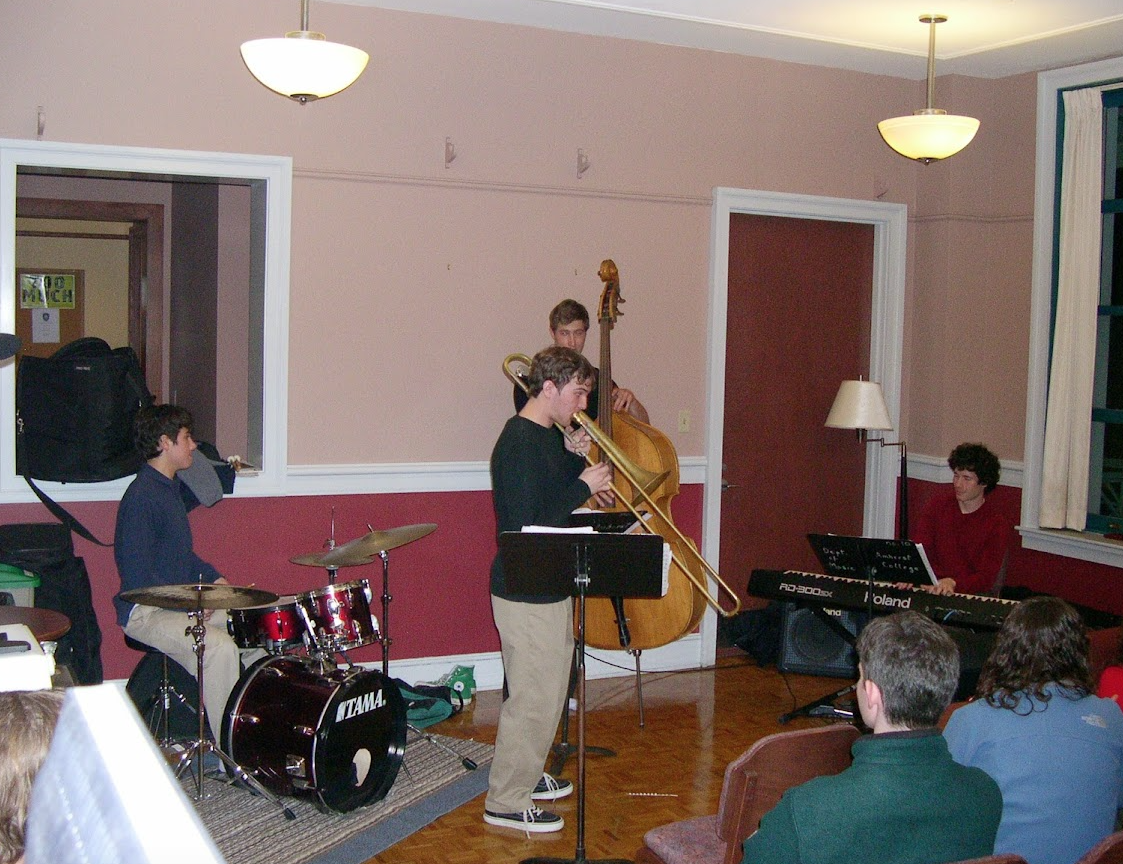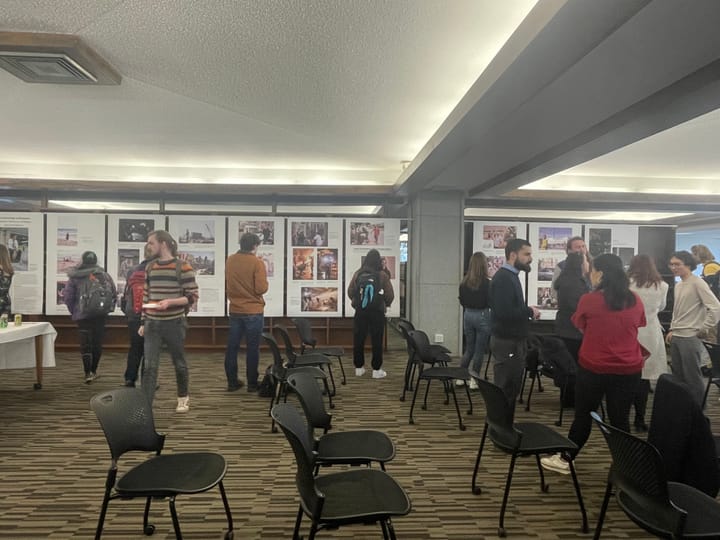The Legacy of Jazz@Schwemms
Jazz@Friedmann Room has been an important recurring social event on campus amid a slow return to “normalcy.” Davis Rennella ʼ24 chronicles the founding of the program’s predecessor, Jazz@Schwemms.


Jazz@Friedmann Room has been a staple of jazz at Amherst since the pandemic began. Many may not know that its predecessor, Jazz@Schwemms, has been hosting both student and professional performances for over a decade. It owes its existence all to a few faculty and students who wanted to make the jazz scene at Amherst come into its own. I talked with Rufus Tyler Lincoln Professor of Biology, Emeritus Dominic Poccia, a retired biology professor and baritone sax player, and Bruce Diehl, the director of jazz performance at Amherst, to learn more about the history of the program and hear their stories.
Back in the early 2000s, Jazz ensembles at Amherst shared the Buckley Recital Hall with the Amherst Symphony Orchestra. And while its booming acoustics and red-carpeted aisles can certainly elevate any performance, Poccia wanted a place that the jazz scene at Amherst could call its own. With help from student and dedicated trombonist Alex Rodriguez ’07, he first hatched the idea of the Schwemm’s scene. With some financial support from the college, the backroom which today’s students visit for grab-n-go lunches was converted into a small jazz club.
A far cry from the cavernous and brightly lit stage in Buckley, the stage at Schwemm’s was not a stage at all, but merely a clearing among the wooden tables for musicians to perform. With the music stands just an arm’s reach away from the audience, the intimate atmosphere allowed for more engagement between the performers and the audience. Students who were waiting for their food at the cafe just outside would hear the music and poke their heads in, and could tell their friends about the free live music happening right in the middle of campus. And listening wasn’t the only way students could engage. Jazz@Schwemms saw a number of talented student groups perform over the years at the 9 p.m. slot.The very first performance came from the Blue Nomads quintet in October 2007. Bruce told me that performing at Schwemm’s was a great way for young musicians to test out their skills in front of a live audience, a tradition that continues to this day.
For most of Jazz@Schwemms’ history, the 10 p.m. spot has belonged to Poccia and his various ensembles of local jazz musicians, including the Eclectic Jazz Quartet, Ask Me Now, and the Secondary Messengers. Although it was always fulfilling to play in these groups, Poccia’s most exciting experiences came when playing alongside groups that specialized in improvisation. While playing with Reflections, multiple players would improvise simultaneously and feed off one another to create counterpoint in real time. Where many ensembles save improv for individual musicians during their solos, this group left a much larger share of the performance unplanned, allowing a unique story to be spun out by the players every time they stepped on stage.
“What happens in the human brain during improvisation seems almost magical,” Poccia told me. He explained that while you’re in an improvisational flow state, the type of thinking that you can put words to gets shut down, and is replaced by a stream of ephemeral ideas. There is hardly any space between generating such ideas and executing them on the instrument. And while playing in time to music, there isn’t space to stop and think about whether playing a certain lick will be the best decision — you simply have to feel it in your gut. He told me that it can be demanding, but that it’s exciting to discover amazing melodies and gestures seemingly coming out of nowhere. “You surprise yourself,” he said, and then try to run with whatever you just heard yourself play.
Creating an enchanting tune on the fly doesn’t just come from magic. As a biology professor, Poccia had a unique perspective on the workings of the brain during jazz improvisation. He told me about a neuroscience study where jazz musicians were instructed to play music while under an MRI machine in order to find out what parts of the brain are the most active during improvisation. The scientists found out that the parts devoted to rational thought were shut down to make room for implementing ideas without holding back. Sections of the brain devoted to language saw an increase in activation — a mark of how jazz acts like a musical conversation. There was also a lot of activity in the section of the brain responsible for emotion and long-term regulation. In other words, the part of the brain that is responsible for turning raw stimuli into stories. He said that improvising is, in a way, all about telling a story through music and creating meaning based on past experiences and emotions.
Poccia also told me that jazz requires a special attunement to the performers around you. Players have a greater personal responsibility for the content of the performance than in other genres and need to be sensitive and alert enough to respond to the moody chords on the keys with their own taste of melancholy. It takes the right group of people to make this happen: “If you play with someone with an ego issue,” he said, “they’ll just wait for their solo … they may be very skilled, but not very musical.” The audience also has an important role to play — seeing people smile and move to the music gives the players confidence that what they’re playing works for people, and this inspires greater effort and creativity.
Because of the inherent social component of jazz, the pandemic took a heavy toll on jazz musicians and their craft. Where Poccia could keep busy in the past, playing around 70-80 gigs during 2019, he only played three in 2020 — only three nights over the course of the year where he could play with other musicians and get the creative juices flowing as they ought to. For most jazz musicians, it was difficult to find the motivation to practice in the meantime, since there are only so many scales and chord progressions to play while waiting to actually apply them with other musicians. This musical isolation proved onerous, and many in Poccia’s circles stopped playing entirely.
Poccia came out of retirement to play in the Friedmann Room this past March. Despite a long hiatus, the jazz scene at Amherst has returned in full swing. The venue has moved upstairs, and Jazz@Schwemms has returned as Jazz@Friedmann Room. Bruce told me that it’s a good space — although it’s a bit less up close and personal than the original backroom at Schwemms. The big, raised stage makes for an overall better setup for the musicians, and more space allows for more people in the audience. The best jazz musicians of the pioneer valley have taken back their home, and they are here to stay. So, why not stop by Keefe next semester on a Thursday night?





Comments ()